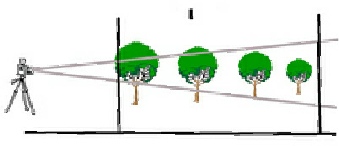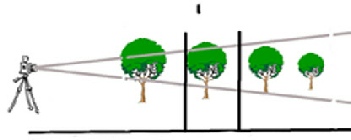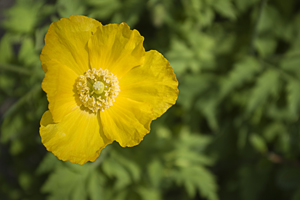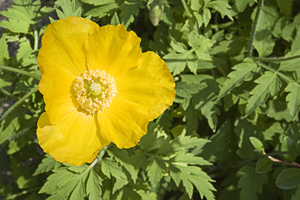



Depth of Field 1
Depth of Field is defined as that part of an image that is in acceptable focus from the lens to the horizon. Here’s a diagram showing the effect of Aperture.
There are just 2 things that effect depth of field, Scale and Aperture. The effects of Aperture can be shown to be the Scale Ratio between the Sensor size and the Aperture size, but let’s keep it simple.
1. Scale. This is a tricky one to get your head around unless you make models or did technical drawing at school.
Say you wanted to draw a picture of your house you would have to either use a very large piece of paper or reduce all the dimensions so it would fit onto the sheet of paper you have. If you used a Scale of 100:1 then every dimension of 1 metre in your house would be a dimension of 1 cm in your drawing, your drawing would be 100 times smaller than your house.
In our camera the sheet of paper is your sensor which has a fixed size, and your framing determines the Scale.
For example, if something that is 1 cm in the real world is being projected onto your sensor life size i.e. 1 cm, then the Scale ratio is 1:1, Depth of Field would be narrow (very narrow). At the other extreme if you fill your sensor with the image of say a 60 foot tree, then your lens system is Reducing the size of the tree projection to fit your sensor, and the scale ratio will be higher around 1000:1, Depth of Field would be wide.
The size of the sensor our camera uses effects this Scale ratio too. Point and Shoot and Bridge cameras have a tiny sensor, on these cameras the lens has to Reduce the image to fit the small sensor more than cameras with an APS or FF sized sensor, which means the Scale ratio will be higher and the Depth of Field wider than a camera with a larger sensor. This is great when we want to get close to a subject where the increase in Depth of Field helps, but can give disappointing results when we want Selective Focus shots (where the subject is sharp, but the background blurred) where we want a narrow Depth of Field.
From this follows that a wide angle lens (which is reducing a wide vista onto your sensor so it has a very high Scale ratio) will have a greater Depth of Field than a telephoto lens (which is magnifying part of the scene in front of you and has a lower Scale ratio).
Likewise when you move closer to your subject the subject gets larger in relation to your sensor size, the Scale ratio gets less and Depth of Field gets smaller.
2. Aperture. Is a lot simpler. The smaller the Aperture (larger f number) the WIDER the Depth of Field
Conversely the larger the Aperture (Smaller f number) the NARROWER the Depth of Field.
Large Aperture (Small f number)
Notice that the Plane of Focus is where the lens is actually focused and the Depth of Field extends less towards the camera and more towards the horizon, roughly 1/3rd towards the camera and 2/3rd's towards the horizon. The focus control on the lens will move this Plane of Focus closer or further from the camera position.
The two vertical lines in the drawing indicate the extent of acceptable sharpness you will get with different apertures. It is not as fixed as the diagram might suggest, in practice, the sharpness gradually falls off the further you are from the plane of focus, the lines indicate ACCEPTABLE focus.
Pic 1. F5.6 at 1/250th of a second
Pic 2. F22 at 1/15th of a second
Practical Uses As photographers we can, and should, use these two ways of controlling
Depth of Field which can be altered to our advantage to get the image you want. When
photographing a flower, or other close up subject, it can pay to use a large aperture
(small f number) as this will give a limited depth of field and make the in focus
flower stand out against the other foliage which will appear rather blurry, as in
Pic 1 below, even though it will make focusing more critical to the point of using
manual mode over-
Conversely we may want a record shot of the flower showing the foliage as well, then a small Aperture (large f number) would give you the result in Pic 2.
As we saw when we discussed Exposure, Aperture and Shutter Speed have to balance, these were shot with the camera set in Aperture Priority Mode notice how the camera has altered the shutter speed to compensate for the lower level of light passing through the lens at the small (f22) aperture by using a slower shutter speed. The practicalities of this mean the first wide aperture shot with it’s fast Shutter Speed could probably be shot hand held, the second with it’s slower Shutter Speed will probably have camera shake unless you use a tripod!
It’s a safe bet that a camera on Auto everything would not have captured either of the two shots above. Probably something in between.
By using Aperture Priority we are taking conscious control of our camera and making it record the picture WE want and not what it thinks we want!
Auto Focus would probably have not worked for us either, it would be just as likely to have focused on the background as on the flower. With most DSLR’s you can set the area that the camera will focus on, but at magnification greater than this the Depth of Field is so narrow manual focusing works best, usually by moving the whole camera/lens closer or further away a fraction rather than trying to focus with the lenses focus ring.
Just to recap:-
Small apertures (large f number) increases depth of field.
Large aperture (small f number) decreases depth of field
Wide angle lenses have greater depth of field than long (telephoto) lenses. They have a higher Scale Ratio than telephoto lenses that have a lower Scale Ratio.
The closer you get to an subject the less depth of field you have. You are reducing the Scale Ratio.
Cameras with a small sensor will have a wider depth of field than cameras with larger sensors.
The phrase DEPTH OF FIELD means nothing more than that part of the picture from the lens to the horizon that is in acceptable focus.


—–Depth of Field —––
Small Aperture (Large f number)
Plane of Focus
Plane of Focus
-

